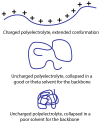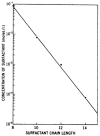Intermolecular Interactions in Polyelectrolyte and Surfactant Complexes in Solution
- PMID: 30960035
- PMCID: PMC6401804
- DOI: 10.3390/polym11010051
Intermolecular Interactions in Polyelectrolyte and Surfactant Complexes in Solution
Abstract
Polyelectrolytes are an important class of polymeric materials and are increasingly used in complex industrial formulations. A core use of these materials is in mixtures with surfactants, where a combination of hydrophobic and electrostatic interactions drives unique solution behavior and structure formation. In this review, we apply a molecular level perspective to the broad literature on polyelectrolyte-surfactant complexes, discussing explicitly the hydrophobic and electrostatic interaction contributions to polyelectrolyte surfactant complexes (PESCs), as well as the interplay between the two molecular interaction types. These interactions are sensitive to a variety of solution conditions, such as pH, ionic strength, mixing procedure, charge density, etc. and these parameters can readily be used to control the concentration at which structures form as well as the type of structure in the bulk solution.
Keywords: complexes; electrostatic; hydrophobic; micelle; molecular; polyelectrolyte; surfactant.
Conflict of interest statement
The authors declare no conflict of interest.
Figures
















Similar articles
-
A detailed assessment on the interaction of sodium alginate with a surface-active ionic liquid and a conventional surfactant: a multitechnique approach.Phys Chem Chem Phys. 2022 Jun 8;24(22):13738-13762. doi: 10.1039/d2cp00221c. Phys Chem Chem Phys. 2022. PMID: 35612295
-
Effect of hydrophilicity or hydrophobicity of polyelectrolyte on the interaction between polyelectrolyte and surfactants: molecular dynamics simulations.J Phys Chem B. 2012 May 10;116(18):5516-26. doi: 10.1021/jp212089d. Epub 2012 Apr 30. J Phys Chem B. 2012. PMID: 22524634
-
Polyelectrolyte/surfactant mixtures in the bulk and at water/oil interfaces.Adv Colloid Interface Sci. 2014 Mar;205:87-93. doi: 10.1016/j.cis.2013.10.007. Epub 2013 Oct 12. Adv Colloid Interface Sci. 2014. PMID: 24268973 Review.
-
Interactions between an Associative Amphiphilic Block Polyelectrolyte and Surfactants in Water: Effect of Charge Type on Solution Properties and Aggregation.Polymers (Basel). 2021 May 25;13(11):1729. doi: 10.3390/polym13111729. Polymers (Basel). 2021. PMID: 34070596 Free PMC article.
-
Polyelectrolyte-Surfactant Complexes As a Formulation Tool for Drug Delivery.Langmuir. 2022 Nov 8;38(44):13330-13343. doi: 10.1021/acs.langmuir.2c02166. Epub 2022 Oct 24. Langmuir. 2022. PMID: 36278880 Review.
Cited by
-
Ionic self-assembly of redox-active polyelectrolyte-surfactant complexes: mesostructured soft materials for electrochemical nanoarchitectonics.Sci Technol Adv Mater. 2025 Apr 29;26(1):2497309. doi: 10.1080/14686996.2025.2497309. eCollection 2025. Sci Technol Adv Mater. 2025. PMID: 40458735 Free PMC article. Review.
-
Multiheaded Cationic Surfactants with Dedicated Functionalities: Design, Synthetic Strategies, Self-Assembly and Performance.Molecules. 2023 Aug 1;28(15):5806. doi: 10.3390/molecules28155806. Molecules. 2023. PMID: 37570776 Free PMC article. Review.
-
Polymer-Induced Drag Reduction in Dilute Newtonian and Semi-Dilute Non-Newtonian Fluids: An Assessment of the Double-Gap Concentric Cylinder Method.Ind Eng Chem Res. 2022 Aug 3;61(30):11197-11208. doi: 10.1021/acs.iecr.2c00899. Epub 2022 Jul 20. Ind Eng Chem Res. 2022. PMID: 35941848 Free PMC article.
-
Surfactants' Interplay with Biofilm Development in Staphylococcus and Candida.Pharmaceutics. 2024 May 15;16(5):657. doi: 10.3390/pharmaceutics16050657. Pharmaceutics. 2024. PMID: 38794319 Free PMC article.
-
Quantitative Biosensing Based on a Liquid Crystal Marginally Aligned by the PVA/DMOAP Composite for Optical Signal Amplification.Biosensors (Basel). 2022 Apr 7;12(4):218. doi: 10.3390/bios12040218. Biosensors (Basel). 2022. PMID: 35448279 Free PMC article.
References
-
- Tadros T.F. An Introduction to Surfactants. Walter de Gruyter; Wokingham, UK: 2014.
-
- Rosen M., Kunjappu J. Surfactants and Interfacial Phenomena Index. 4th ed. John Wiley & Sons; Hoboken, NJ, USA: 2012.
-
- Rhein L.D., Schlossman M., O’Lenick A., Somasundaran P. Surfactants in Personal Care Products and Decorative Cosmetics. 3rd ed. CRC Press; Boca Raton, FL, USA: 2006.
-
- Van der Meeren P., Verstraetet W. Surfactants in relation to bioremediation and wastewater treatment. Curr. Opin. Colloid Interface Sci. 1996;1:624–634. doi: 10.1016/S1359-0294(96)80100-2. - DOI
Publication types
LinkOut - more resources
Full Text Sources

